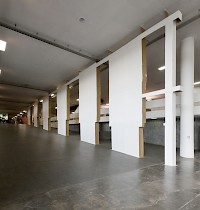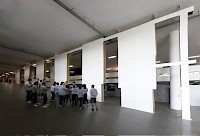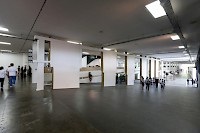29th São Paulo Biennial, curated by Moacir dos Anjos and Agnaldo Farias, 25 September – 12 December 2010
Starting from an inquiry into the expressive and philosophical potential of space, Spain-based, Portuguese artist Carlos Bunga enacts spatial processes of construction and deconstruction. Through an improvisatory technique, he superimposes large-scale cardboard forms over existing constructions. His architectural thinking, concerned with the emergence of space out of a conjunction between temporal cycles and spatial hypostases, manifests in experiments with documentation, color, ephemeral materials, and fragmentation. The work gains relevance as a critical confrontation with art historical models, institutional critique, reconsiderations of conceptualism, and investigations into the invisible side of representation.
Bunga's work in the 29th São Paolo Biennial, Simultâneo, fragmentado, descontínuo (2010) ('Simultaneous, Fragmented, Discontinuous'), seemed to cite various architectural paradigms of different epochs, and yet preserve a floating, atemporal character in its monumentality: a row of columns made from cardboard, stuck together with tape, overpainted in white and unfinished on the sides and back. Situated on the ramp of the existing building, it conferred a sense of movement and reconfigured its own architectonics, the work recalled the artist's earlier constructions built inside galleries and institutional edifices: labyrinthine compartments in fragile cardboard, painted in monochromatic pictorial planes, which after completion are cut down and collapsed, leaving a deserted landscape of remains. This new spatial experience intermixed construction with deconstruction, which should, as Bunga explained, be understood as simulations or re-creations, meant to superpose different reference-frames (Bunga, in an interview recorded in Lisboa, March, 2010 _____).
'Há sempre um copo de mar para um homem navegar' ('There is always a cup of sea to sail in') served as a title for the Biennial, curated by the Brazilians Moacir dos Anjos and Agnaldo Farias. The phrase came from a verse by the poet Jorge de Lima (1895-1953) in Invenção de Orfeu (1952) ('Invention of Orpheus'), which expressed an attempt to reunite experimental poetics and politics. The curators sought to blend an activist, conceptual attitude in art with qualities like tangibility and poetic materiality. Here experimentation was understood as a political vector – literary references were strategically designed to break the hermetic, conceptual language of art and bring forward sensory-based experiences. While the curators intended to crystallize a new sense of politics, one which was not separate from art and yet expressed the utopian power of art, they also aimed for a greater democratization and inclusion (by abolishing national presentations, working with a team of curators, and increasing the contacts with Latin America and Africa). However, their discourse seemed to be the priority, rather than practical efficacy. When 159 artists from all over the world came together, in a highly heterogeneous exhibition, it was impossible to discern a singular political stance. The architectural organization apparently recognized this by fragmenting the exhibition space into six Terreiros, which evoked Brazilian plazas, squares, terraces, and inner courtyards, with their specific atmosphere and conviviality, corresponding further to six thematic issues (for instance 'I Am the Street' or 'Remembrance and Oblivion'), which again carried a certain poetic resonance, yet lacked precision and concreteness.
In this curatorial context, the work of Bunga detached itself from most of the other documentary, analytical works, constructed as they were around specific social and political subject matter such as economic shortages, migration, the labour market, repression, exclusion. Instead, Bunga incorporated a more practical repository for value and meaning. By this it conformed to the thematic of the 29th Biennial without being literal. In the institutional context of the Biennial – itself a solid structure overloaded with sedimented practices which sustain the edifice of global artworld – Bunga re-cast the building itself in fragile, perishable material, depriving it of its inherited connotations. His colonnade, only apparently sustaining the ramp, could be considered a fake, but also a fragment that by abandoning its context expressed an absence. In this sense, the work’s polemical institutional context reenacted iconoclastic confrontations with the 'image' – as an expression of power, status and authoritarian meaning.
Without adhering to a particular aesthetic of a style, Bunga’s colonnade seemed to cite the idea of historical vestige or ruin while at the same time representing a construction of the future. It contradicted its context by bringing spatial ambiguity and the presence of foreign temporal cycles with a slight fictionalizing impulse. In this way, his process of reconstruction, while initially implying destabilization and disorder, avoided dogmatic politicization, used the means that the Biennial curators designated as experimentalism, tangibility, and utopianism to induce a poetics of loss, abstraction, laconicity. He in effect mirrored the curatorial goals to test the potency of their rhetoric. By depicting an essentialized architecture or scenery, he freed and made visible the space itself as a potential generator of critical meaning. Political in a more subversive way than it first appeared, Bunga’s work proposed a shift to thinking differently about the context of architectural reference, a perspective that negated the roots a whole system of representation while, in turn, manifesting the power to regenerate it.
References
Bunga, Carlos, Interview, recorded in Lisboa, March, 2010


